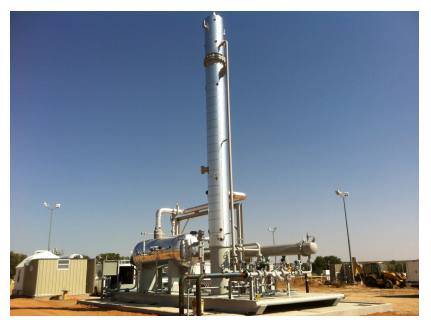
The natural gas liquids (NGLs) or field condensate produced in natural gas fields must be stabilized for storage and transportation in pressurized and/or atmospheric vessels. Joule offers condensate stabilization systems that create an easily storable liquid product while recovering more lights ends for fuel or sales gas. Each system is designed and constructed to meet the desired product or sales component specifications including stabilized NGLs and natural gasolines.
Raw natural gas liquids (NGLs) are introduced into the stabilization unit at a high pressure through a shutdown valve and preheated to a specific temperature. Afterwards, the pressure of the liquid feed is dropped via a control valve, creating both a liquid and gas phase. At this point water can be flashed out and removed from the stream, while any light gasses that escape can be flashed off or recovered. The remaining hydrocarbon liquids are then heated through a bottom exchanger before entering into a contactor or stabilizer tower. Tower designs can vary from tray to packed column, but the idea is generally the same: a reboiler heats the hydrocarbon liquid, causing two separate phases again. Lighter hydrocarbons with lower boiling points rise up the tower as a gas, while the heavier hydrocarbons contact the trays or packing in the column, collect, and stream down to the bottom of the tower as a liquid. Using either flash drum liquids or another technique, the NGLs are cooled and routed to a pipeline or storage facility. The vapor that rose through the tower may be flashed off in a downstream flare (if permitted by regulations) or routed to an NGL recovery skid designed to compress and store the lighter hydrocarbons for later processing or use.
Standard System Offerings:
2,000 BBL/D
5,000 BBL/D
10,000 BBL/D
20,000 BBL/D